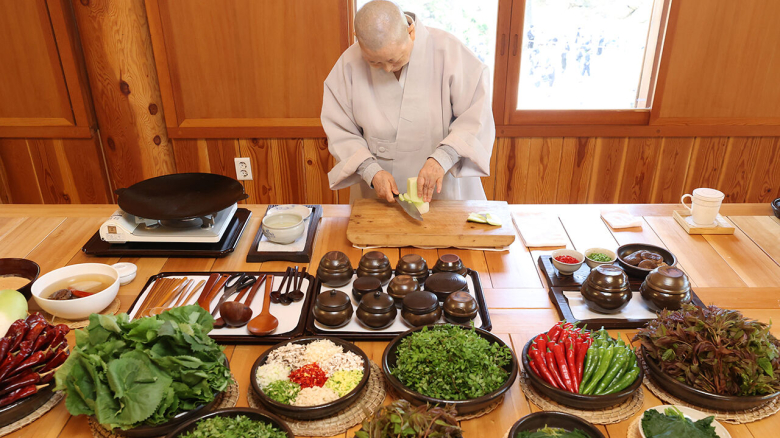When people think of Korean food, dishes like kimchi, bulgogi, and bibimbap often come to mind. However, among these, “temple cuisine,” rooted in Buddhist traditions, holds a unique and profound appeal. Temple cuisine refrains from using meat and either excludes or greatly minimizes the use of five pungent vegetables (green onions, garlic, leeks, chives, and onions), respecting the natural flavors and aromas of the ingredients. As wellness, health, and healing have become increasingly important to modern people, temple cuisine is gaining attention. Many foreign tourists also seek to try this style of Korean food, saying, “I’d like to experience vegetarian and vegan-friendly Korean food.” In this article, we’ll explore how temple cuisine developed, its unique characteristics, and how you can enjoy it yourself.
The Relationship Between Buddhist Philosophy and Temple Cuisine
Temple cuisine embodies the principles and beliefs of Buddhism. Based on the precept of non-violence (Ahimsa), it avoids meat, and instead of strong, stimulating flavors, it aims to bring out the pure taste of natural ingredients. The avoidance of the five pungent vegetables originates from the Buddhist view that their strong taste and aroma can disturb one’s meditation and mindfulness. Despite these dietary restrictions, Korean temple food has evolved to create “subtle yet profound flavors” by using a rich variety of ingredients and cooking techniques.
Since ancient times, monks have prepared meals using vegetables grown around the temple, crops from their gardens, and wild greens from nearby mountains. Seasonal herbs and wild vegetables are often used, and fermented foods like pickles, kimchi, soybean paste (doenjang), and chili paste (gochujang) have been developed for long-term storage. As a result, temple cuisine has evolved into a healthy and balanced diet with moderate seasoning and the deep complexity of fermentation and aging.
Representative Dishes in Temple Cuisine
Temple cuisine generally uses minimal seasoning to preserve the ingredients’ natural taste. One of the most iconic dishes is “Sanchae Bibimbap” (vegetable bibimbap). In temples, a variety of mountain greens are cleaned and prepared either as seasoned or stir-fried side dishes, then placed on top of steamed rice and lightly mixed with a sauce. The colors and aromas of each vegetable blend harmoniously, offering complex flavors even without any meat.
“Tofu dishes” are another commonly seen feature of temple cuisine. Tofu captures the essence of soybeans and becomes a hearty meal when combined with pickled vegetables and fermented sauces. Interestingly, even without using pungent aromatic vegetables like garlic or scallions, temples create umami-rich flavors using ingredients like perilla seeds, mushrooms, and nuts. Temple food, created from nature’s bounty, reflects a deep belief that food prepared in this way is truly nourishing for both body and mind.

Health and Healing Perspectives
Temple cuisine is far more than just vegetarian food. Cooking techniques are typically simple, and artificial additives are avoided, allowing the ingredients’ natural colors and flavors to shine while keeping calorie and cholesterol levels low. By incorporating the benefits of traditional Korean fermentation, temple cuisine is believed to support gut health and boost the immune system. Some studies even suggest that regular consumption of temple food can aid in weight management and prevent lifestyle diseases.
Most importantly, the “attitude toward food” makes temple cuisine culturally unique. From the moment ingredients are cleaned and prepared, everything is done with care and respect, avoiding waste or extravagance. During community meals (offering meals), participants are encouraged to eat with gratitude and not leave leftovers. This mindful approach to food resonates with many modern people, connecting with the concept of “mindfulness” and offering not just nourishment but mental wellness as well.
Temple Cuisine Experience Programs
In South Korea, you can find various programs where you can directly experience and even cook temple cuisine yourself. Some temples offer these experiences in tandem with “Temple Stay” programs, where participants can learn about cooking temple food, make fermented sauces, or prepare vegetables. In cities, many temple cuisine restaurants and cooking classes are available, making it easy for foreigners to book and participate.
Typical dishes taught during such programs include seasoned mountain greens, temple-style bibimbap, and braised lotus root. Some classes introduce traditional cooking tools and real fermented sauces, enhancing immersion in the serene atmosphere of hanok (traditional Korean houses). At the end of the class, participants often dine together, sharing and evaluating the food they made. The tips and camaraderie gained from these interactions become another rewarding part of the experience.
Tips for Visiting Temple Cuisine Restaurants
Temple cuisine restaurants are often found in quiet alleys or near temples rather than in bustling city centers. Their menus exclude all meat and seafood, making them ideal for vegetarians and vegans. However, as some dishes may still contain mild forms of the five pungent ingredients, those seeking 100% vegan meals should confirm details in advance. With the rising interest from international visitors, many places now offer English menus or staff who can provide explanations in English, so communication is rarely an issue.
Some restaurants offer multi-course set meals featuring various vegetable dishes, stews, rice, and desserts served in order. While the price point is slightly higher than regular Korean restaurants, diners often find the elegant plating, carefully selected ingredients, and unique preparation techniques well worth it. Especially for travelers accompanied by foreign guests, these meals are often recommended as “a special way to experience traditional Korean Buddhist food culture.”
Conclusion: Finding Balance for Body and Mind at the Table
Temple cuisine is a refined dining culture born from meditation and spiritual practice. As a form of “slow food” that harmonizes with nature, it creates nourishing and wholesome meals using the ingredients’ natural flavors, without excessive seasoning. More than just food, the ethos of gratitude and mindful consumption speaks to people in today’s fast-paced world. As health and healing become central themes in modern life, temple cuisine is emerging not merely as a cultural remnant but as a contemporary lifestyle for wellness, accessible to both Koreans and international visitors alike.
If you’re traveling in Korea and looking for a unique dining experience, we highly recommend visiting a temple cuisine restaurant or joining a cooking program. The subtle broth, refreshing seasoned greens, and savory fermented sides show how fulfilling a meal can be without meat. Along the way, you’ll likely reflect on your eating habits and approach to life, gaining a rare opportunity to restore balance to both body and mind.


WeBring Service : Provides personalized services to foreigners living in Korea
Exclusive offer: Introducing foreign car rental in Korea, WeBring-SoCar

